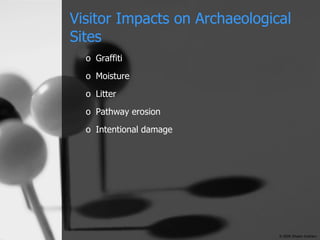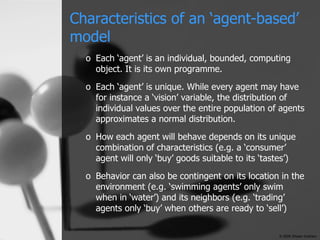VisitorSim
- 1. Simulating the impact of visitors at archaeological sites with agent-based modeling: potentials & possibilities Dr. Shawn M. Graham, RPA, MIFA electricarchaeologist.wordpress.com graeworks.net © 2006 Shawn Graham
- 2. Visitor Impacts on Archaeological Sites Graffiti Moisture Litter Pathway erosion Intentional damage © 2006 Shawn Graham
- 3. Desirability of knowing where visitors are likely to wander Understand likely impact of signage in particular locations. Control the ‘message’ visitors learn by identifying crucial pathways and intersections through the site. Identify potential areas at risk to damage from visitors. Avoid unintentional routing of visitors to sensitive areas. Develop alternative pathways to major monuments so that impact on the site may be scheduled and controlled. Can visitor interactions with a site be predicted and so be mediated? Yes. © 2006 Shawn Graham
- 4. Agent-based modeling is a method whereby individual visitors are simulated within a computer and allowed to interact with each other and with their environment agents environment © 2006 Shawn Graham
- 5. Characteristics of an ‘agent-based’ model Each ‘agent’ is an individual, bounded, computing object. It is its own programme. Each ‘agent’ is unique. While every agent may have for instance a ‘vision’ variable, the distribution of individual values over the entire population of agents approximates a normal distribution. How each agent will behave depends on its unique combination of characteristics (e.g. a ‘consumer’ agent will only ‘buy’ goods suitable to its ‘tastes’) Behavior can also be contingent on its location in the environment (e.g. ‘swimming agents’ only swim when in ‘water’) and its neighbors (e.g. ‘trading’ agents only ‘buy’ when others are ready to ‘sell’) © 2006 Shawn Graham
- 6. The ‘environment’ Agents move within a computing environment (technically, a chessboard-like arrangement of computing agents called a ‘cellular automaton’) The environment can be passive (mere ‘background’) ‘ Active’ environments can represent ecological systems (growing vegetation; forest fires; growth medium in a virtual petri dish) The environment can also keep track of the impact of agents (each cell can register and record the presence/absence of agents, whether or not they have altered the environment (‘sheep’ agents eat ‘grass’ which must then ‘regrow’) © 2006 Shawn Graham
- 7. VisitorSim: an agent based model of visitor impacts for archaeological sites Agents represent ‘tourists’ and ‘tour-guides’ Tourists explore the site; will follow other tourists or tour-guides within their range of vision; tour-guides will move towards specific ‘attractions’ in turn (tourists behave essentially like herd animals) Environment consists of an active image of the archaeological site, with open pathways demarcated. © 2006 Shawn Graham
- 8. VisitorSim: an agent based model of visitor impacts for archaeological sites Movement of agents is constrained to the pathways The pathways, divided into individual cells, keep track of the amount of traffic which has passed over each cell (the ‘impact’) Output of the model: map of the site with impact graded from white (marginal impact) through red to black (maximum impact) © 2006 Shawn Graham
- 9. VisitorSim interface: Pompeii Controls for altering visitor movement behaviors ‘ attractions’ agents Setup controls Nb location of ‘attractions’ are simple randomly placed dots for purposes of this initial version of VisitorSim © 2006 Shawn Graham
- 10. VisitorSim output: Pompeii greatest impacts Air-photo image of Pompeii has been stripped away to reveal impact on underlying cells of the environment © 2006 Shawn Graham
- 11. VisitorSim: realistic? Large body of theory to suggest that layout of streets and paths has significant ‘canalizing’ effect on how people move through them The motivations which guide an individual tourist are largely unknowable; simulation of random movement through these pathways is a fair approximation Movements of tour-guides more knowable, related to placement of ‘attractions’ Similarly, famous wall-paintings or other notable remains can be used to simulate ‘centers of gravity’ which will attract visitors © 2006 Shawn Graham
- 12. VisitorSim: a laboratory Can use VisitorSim to test how visitor flow through the site might be altered if certain areas are blocked off. Which configurations lead to the best experience for the visitor (greatest access to ‘attractions’) yet still minimize the impact? Experience of Pompeii can guide tweaking of the model so that optimum conditions can be produced for Herculaneum: adjust the model parameters until it reproduces in simulation what we know to be true of visitor behaviors at Pompeii © 2006 Shawn Graham
- 13. Further Reading Gilbert, N. and K. Troitzsch. 2005. Simulation for the Social Scientist Maidenhead: Open University Press. Graham, S. 2006. ‘ Networks, agent-based models and the Antonine Itineraries: implications for Roman archaeology’ Journal of Mediterranean Archaeology 19.1 Graham, S. 2005. ‘Agent-based modeling, archaeology and social organisation: The robustness of Rome’ The Archaeological Computing Newsletter 63, 1-6. Contact information: [email_address] © 2006 Shawn Graham












![Further Reading Gilbert, N. and K. Troitzsch. 2005. Simulation for the Social Scientist Maidenhead: Open University Press. Graham, S. 2006. ‘ Networks, agent-based models and the Antonine Itineraries: implications for Roman archaeology’ Journal of Mediterranean Archaeology 19.1 Graham, S. 2005. ‘Agent-based modeling, archaeology and social organisation: The robustness of Rome’ The Archaeological Computing Newsletter 63, 1-6. Contact information: [email_address] © 2006 Shawn Graham](https://image.slidesharecdn.com/visitorsim-1209135672999234-9/85/VisitorSim-13-320.jpg)